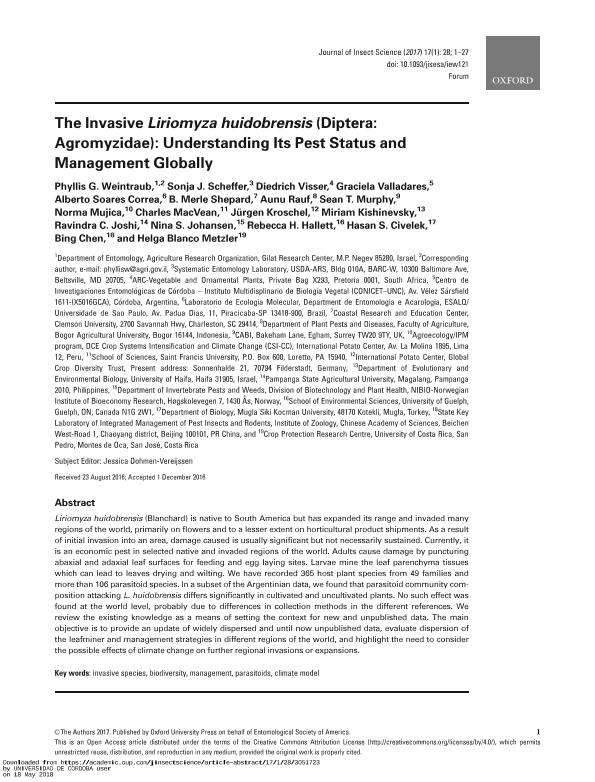Mostrar el registro sencillo del ítem
dc.contributor.author
Weintraub, Phyllis G.
dc.contributor.author
Scheffer, Sonja J.
dc.contributor.author
Visser, Diedrich
dc.contributor.author
Valladares, Graciela Rosa

dc.contributor.author
Soares Correa, Alberto
dc.contributor.author
Shepard, B. Merle
dc.contributor.author
Rauf, Aunu
dc.contributor.author
Murphy, Sean T.
dc.contributor.author
Mujica, Norma
dc.contributor.author
MacVean, Charles
dc.contributor.author
Kroschel, Jürgen
dc.contributor.author
Kishinevsky, Miriam
dc.contributor.author
Joshi, Ravindra C.
dc.contributor.author
Johansen, Nina S.
dc.contributor.author
Hallett, Rebecca H.
dc.contributor.author
Civelek, Hasan S.
dc.contributor.author
Chen, Bing
dc.contributor.author
Metzler, Helga Blanco
dc.date.available
2018-07-12T15:10:35Z
dc.date.issued
2017-01
dc.identifier.citation
Weintraub, Phyllis G.; Scheffer, Sonja J.; Visser, Diedrich; Valladares, Graciela Rosa; Soares Correa, Alberto; et al.; The invasive liriomyza huidobrensis (Diptera: Agromyzidae): Understanding its pest status and management globally; University of Arizona; Journal of Insect Science; 17; 1; 1-2017
dc.identifier.uri
http://hdl.handle.net/11336/51856
dc.description.abstract
Liriomyza huidobrensis (Blanchard) is native to South America but has expanded its range and invaded many regions of the world, primarily on flowers and to a lesser extent on horticultural product shipments. As a result of initial invasion into an area, damage caused is usually significant but not necessarily sustained. Currently, it is an economic pest in selected native and invaded regions of the world. Adults cause damage by puncturing abaxial and adaxial leaf surfaces for feeding and egg laying sites. Larvae mine the leaf parenchyma tissues which can lead to leaves drying and wilting. We have recorded 365 host plant species from 49 families and more than 106 parasitoid species. In a subset of the Argentinian data, we found that parasitoid community composition attacking L. huidobrensis differs significantly in cultivated and uncultivated plants. No such effect was found at the world level, probably due to differences in collection methods in the different references. We review the existing knowledge as a means of setting the context for new and unpublished data. The main objective is to provide an update of widely dispersed and until now unpublished data, evaluate dispersion of the leafminer and management strategies in different regions of the world, and highlight the need to consider the possible effects of climate change on further regional invasions or expansions.
dc.format
application/pdf
dc.language.iso
eng
dc.publisher
University of Arizona

dc.rights
info:eu-repo/semantics/openAccess
dc.rights.uri
https://creativecommons.org/licenses/by-nc-sa/2.5/ar/
dc.subject
Biodiversity
dc.subject
Climate Model
dc.subject
Invasive Species
dc.subject
Management
dc.subject
Parasitoids
dc.subject.classification
Otras Ciencias Biológicas

dc.subject.classification
Ciencias Biológicas

dc.subject.classification
CIENCIAS NATURALES Y EXACTAS

dc.title
The invasive liriomyza huidobrensis (Diptera: Agromyzidae): Understanding its pest status and management globally
dc.type
info:eu-repo/semantics/article
dc.type
info:ar-repo/semantics/artículo
dc.type
info:eu-repo/semantics/publishedVersion
dc.date.updated
2018-07-11T17:58:44Z
dc.identifier.eissn
1536-2442
dc.journal.volume
17
dc.journal.number
1
dc.journal.pais
Estados Unidos

dc.journal.ciudad
Arizona
dc.description.fil
Fil: Weintraub, Phyllis G.. Gilat Research Center; Israel
dc.description.fil
Fil: Scheffer, Sonja J.. United States Department Of Agriculture. Agriculture Research Service; Estados Unidos
dc.description.fil
Fil: Visser, Diedrich. Arc-vegetable And Ornamental Plants; Sudáfrica
dc.description.fil
Fil: Valladares, Graciela Rosa. Consejo Nacional de Investigaciones Científicas y Técnicas. Centro Científico Tecnológico Conicet - Córdoba. Instituto Multidisciplinario de Biología Vegetal. Universidad Nacional de Córdoba. Facultad de Ciencias Exactas Físicas y Naturales. Instituto Multidisciplinario de Biología Vegetal; Argentina
dc.description.fil
Fil: Soares Correa, Alberto. Universidade de Sao Paulo; Brasil
dc.description.fil
Fil: Shepard, B. Merle. Clemson University. Coastal Research and Education Center; Estados Unidos
dc.description.fil
Fil: Rauf, Aunu. Bogor Agricultural University. Faculty of Agriculture; Indonesia
dc.description.fil
Fil: Murphy, Sean T.. CABI; Reino Unido
dc.description.fil
Fil: Mujica, Norma. Centro Internacional de la Papa.; Perú
dc.description.fil
Fil: MacVean, Charles. Saint Francis University; Estados Unidos
dc.description.fil
Fil: Kroschel, Jürgen. International Potato Center. Global Crop Diversity Trust; Alemania
dc.description.fil
Fil: Kishinevsky, Miriam. University of Haifa. Department of Evolutionary and Environmental Biology; Israel
dc.description.fil
Fil: Joshi, Ravindra C.. Pampanga State Agricultural University; Filipinas
dc.description.fil
Fil: Johansen, Nina S.. NIBIO-Norwegian Institute of Bioeconomy Research. Division of Biotechnology and Plant Health. Department of Invertebrate Pests and Weeds; Noruega
dc.description.fil
Fil: Hallett, Rebecca H.. University of Guelph; Canadá
dc.description.fil
Fil: Civelek, Hasan S.. Mugla Siki Kocman University. Department of Biology; Turquía
dc.description.fil
Fil: Chen, Bing. Chinese Academy of Sciences. Institute of Zoology. State Key Laboratory of Integrated Management of Pest Insects and Rodents; China
dc.description.fil
Fil: Metzler, Helga Blanco. University of Costa Rica. Crop Protection Research Centre; Costa Rica
dc.journal.title
Journal of Insect Science

dc.relation.alternativeid
info:eu-repo/semantics/altIdentifier/doi/http://dx.doi.org/10.1093/jisesa/iew121
dc.relation.alternativeid
info:eu-repo/semantics/altIdentifier/url/https://academic.oup.com/jinsectscience/article/17/1/28/3051723
Archivos asociados
